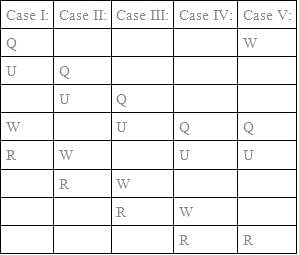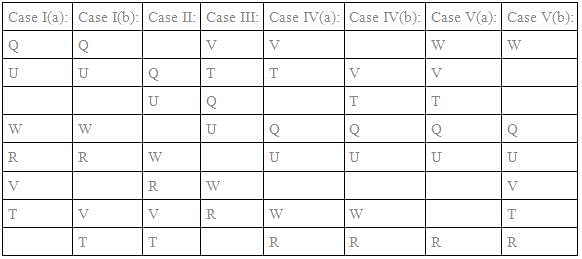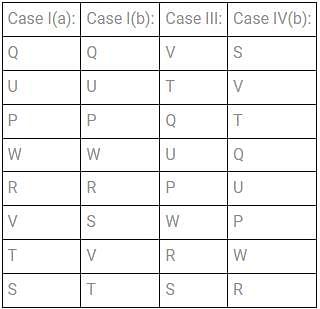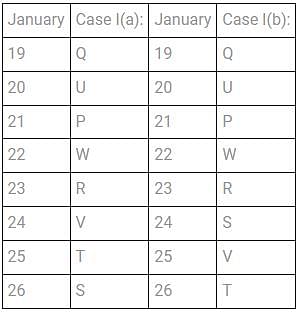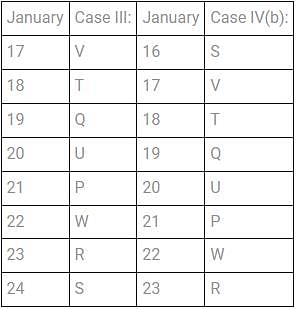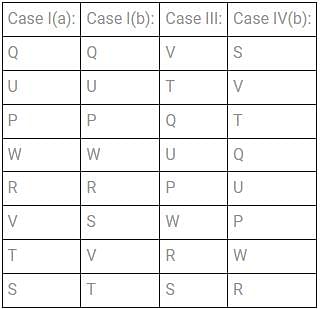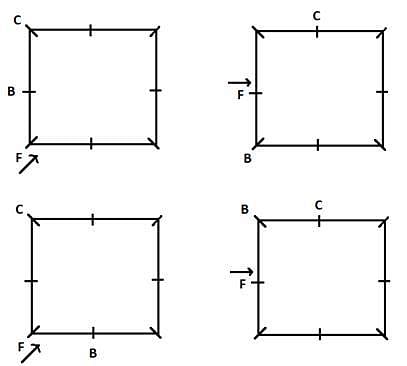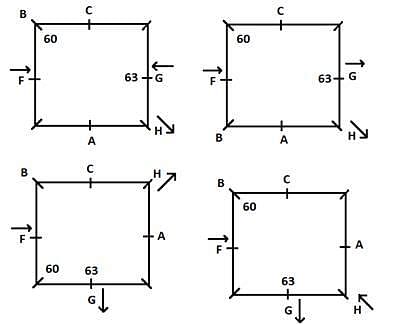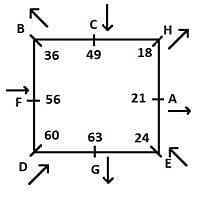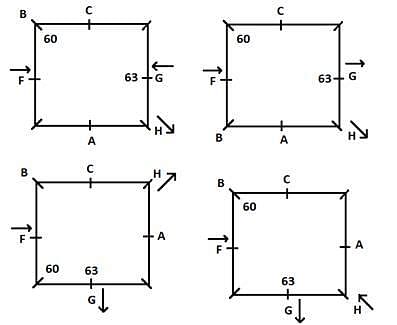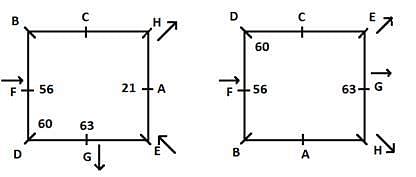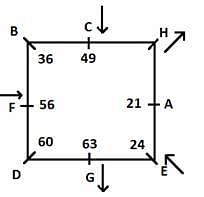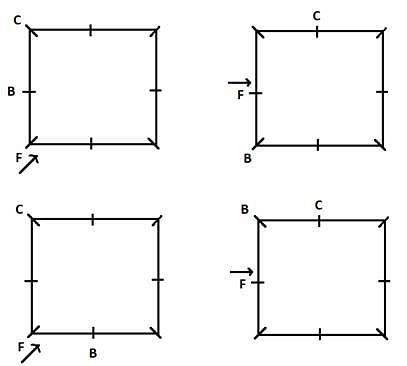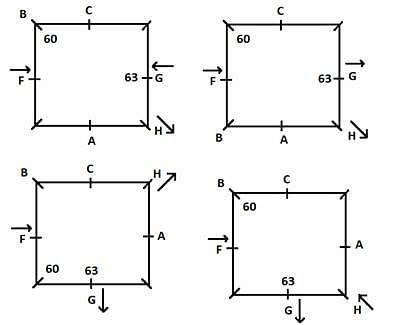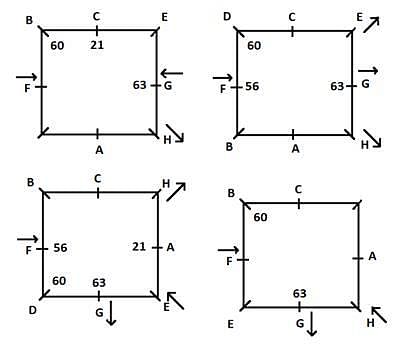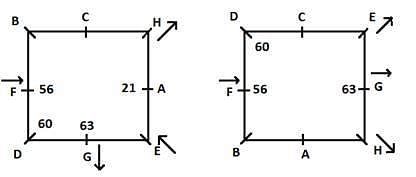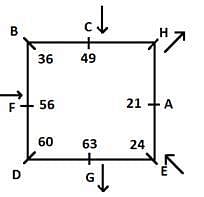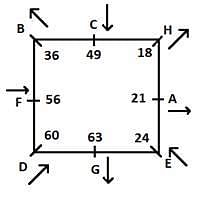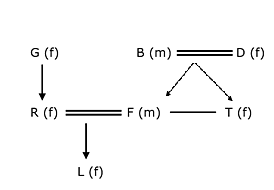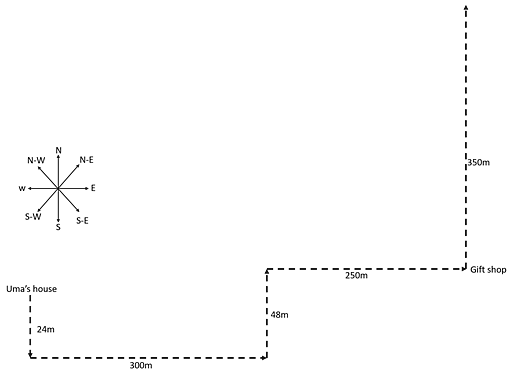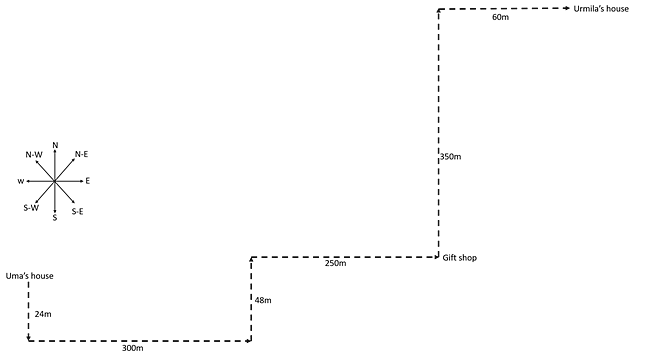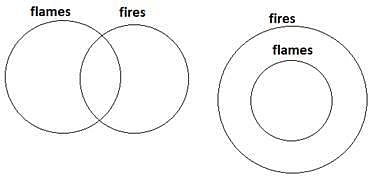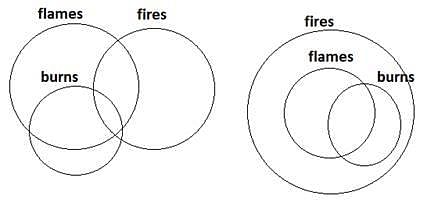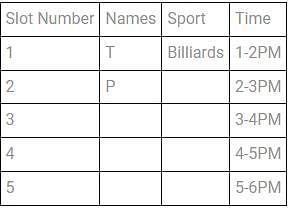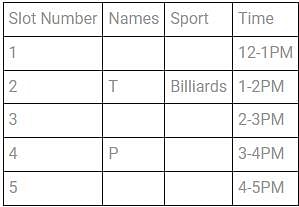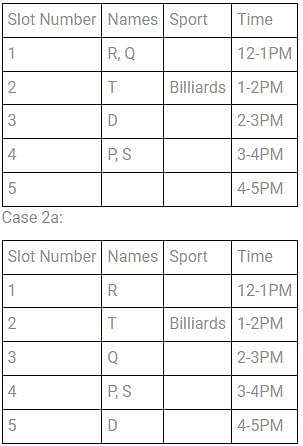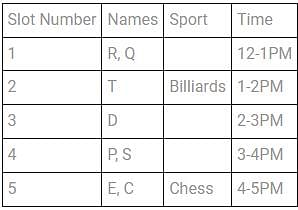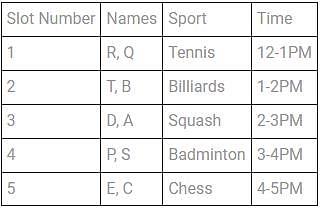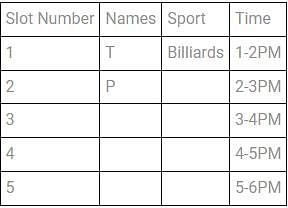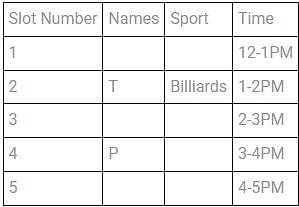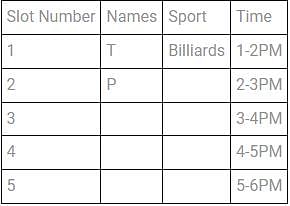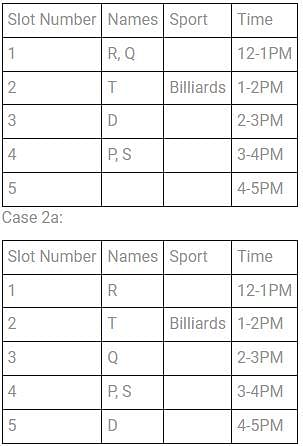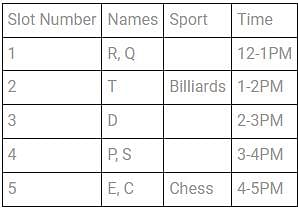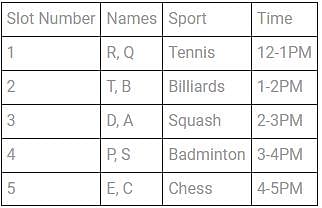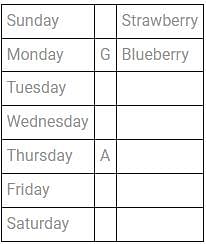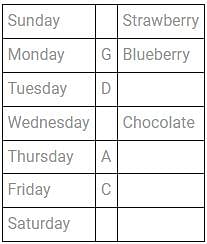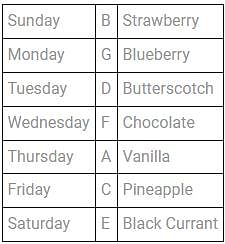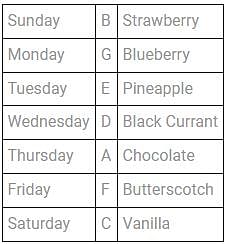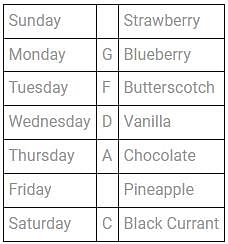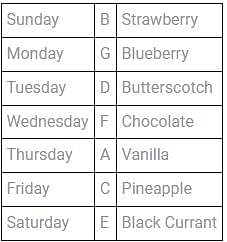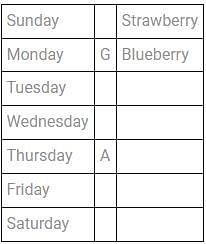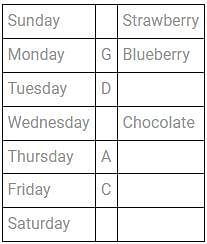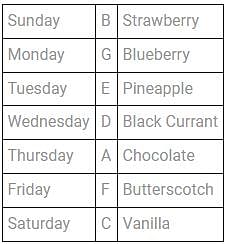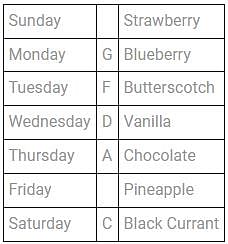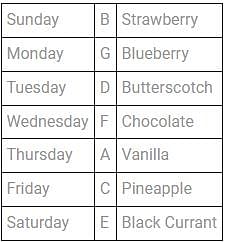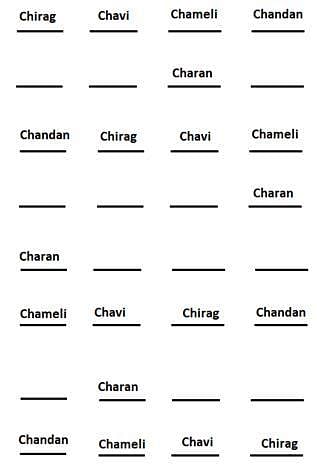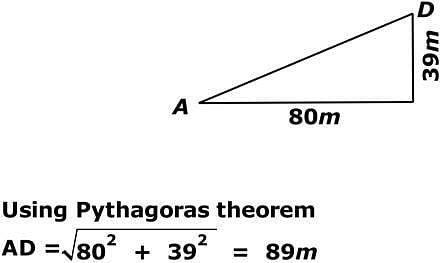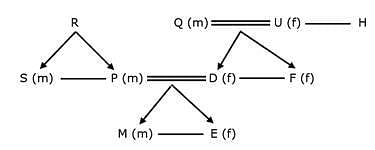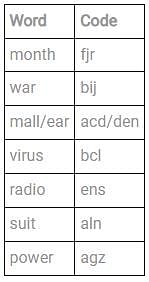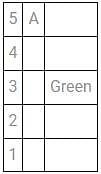EPFO Assistant Mains Mock Test - 1 - Bank Exams MCQ
30 Questions MCQ Test Mock Test Series for EPFO Assistant 2025 - EPFO Assistant Mains Mock Test - 1
Directions [Set of 4 Questions]: In the month of January' 2018, eight persons - P, Q, R, S, T, U, V and W, have their birthdays on different but consecutive dates.
- Two persons have birthdays between W and Q, who has birthday immediately before U.
- T's birthday is immediately after V's birthday.
- Two persons have their birthdays between U's and R's birthday.
- R's birthday is after U's birthday.
- At least two persons have birthdays between P's and S's birthday, which is immediately before/after of neither Q's nor U's birthday.
- Q's birthday is some day between 17th January and 21st January (both exclusive).
- W's birthday is on even numbered date.
- V's birthday is on odd numbered date, but not on a date which is a prime number.
Q. On which date is V's birthday?
Directions [Set of 4 Questions]: In the month of January' 2018, eight persons - P, Q, R, S, T, U, V and W, have their birthdays on different but consecutive dates.
- Two persons have birthdays between W and Q, who has birthday immediately before U.
- T's birthday is immediately after V's birthday.
- Two persons have their birthdays between U's and R's birthday.
- R's birthday is after U's birthday.
- At least two persons have birthdays between P's and S's birthday, which is immediately before/after of neither Q's nor U's birthday.
- Q's birthday is some day between 17th January and 21st January (both exclusive).
- W's birthday is on even numbered date.
- V's birthday is on odd numbered date, but not on a date which is a prime number.
Q. Who among the following has birthday on even numbered date?
I. S
II. U
III. T
I. S
II. U
III. T
| 1 Crore+ students have signed up on EduRev. Have you? Download the App |
Directions [Set of 5 questions]: Eight persons A, B, C, D, E, F, G and H were seated around a square table such that 4 of them were facing the centre while 4 were seated facing outside the centre. There was one person at every corner and one person on every side. The persons seated on the side had age which were multiples of 7 and the persons seated on the corner seats had age which were multiples of 6.
- B was 3rd to the right of G who was aged 63 years.
- A was to the immediate right of H, who was at a gap of 2 from F.
- D was 2nd to the left of E. who was neighbouring G and the one who was 21 years old.
- The one who was 60 years old was seated opposite to H.
- C was 2nd to the left of F who was seated facing inside the centre.
- B was aged twice that of H.
- F was 4 years younger to D.
- The one who was 36 years old was to the immediate left of the one who was 56 years old.
- The one who was 24 years old was 3rd to the left of the one who was 49years old.
- F was seated neighbouring B.
- G's neighbours were seated facing the same direction.
Q. Who among the following was the second youngest?
Directions [Set of 5 questions]: Eight persons A, B, C, D, E, F, G and H were seated around a square table such that 4 of them were facing the centre while 4 were seated facing outside the centre. There was one person at every corner and one person on every side. The persons seated on the side had age which were multiples of 7 and the persons seated on the corner seats had age which were multiples of 6.
- B was 3rd to the right of G who was aged 63 years.
- A was to the immediate right of H, who was at a gap of 2 from F.
- D was 2nd to the left of E. who was neighbouring G and the one who was 21 years old.
- The one who was 60 years old was seated opposite to H.
- C was 2nd to the left of F who was seated facing inside the centre.
- B was aged twice that of H.
- F was 4 years younger to D.
- The one who was 36 years old was to the immediate left of the one who was 56 years old.
- The one who was 24 years old was 3rd to the left of the one who was 49years old.
- F was seated neighbouring B.
- G's neighbours were seated facing the same direction.
Q. Four of the following bear a similar relationship and hence form a group, who among the following is not a part of that group?
Directions [Set of 5 questions]: Eight persons A, B, C, D, E, F, G and H were seated around a square table such that 4 of them were facing the centre while 4 were seated facing outside the centre. There was one person at every corner and one person on every side. The persons seated on the side had age which were multiples of 7 and the persons seated on the corner seats had age which were multiples of 6.
- B was 3rd to the right of G who was aged 63 years.
- A was to the immediate right of H, who was at a gap of 2 from F.
- D was 2nd to the left of E. who was neighbouring G and the one who was 21 years old.
- The one who was 60 years old was seated opposite to H.
- C was 2nd to the left of F who was seated facing inside the centre.
- B was aged twice that of H.
- F was 4 years younger to D.
- The one who was 36 years old was to the immediate left of the one who was 56 years old.
- The one who was 24 years old was 3rd to the left of the one who was 49years old.
- F was seated neighbouring B.
- G's neighbours were seated facing the same direction.
Q. In which of the following groups was the 3rd person seated exactly in between (neighbouring) the 1st and the 2nd person?
Directions [Set of 3 questions]: Study the following information carefully and answer the questions given below:
- 'A @ B' means "A is father of B".
- 'A # B' means "A is Son of B".
- 'A % B' means "A is brother of B".
- 'A & B' means "A is sister of B".
- 'A ≤ B' means "A is mother of B".
- 'A $ B' means "A is daughter of B".
Q. How is L related to T in given expression "G≤R≤L$F#B@T$D"?
Directions [Set of 4 questions]: Study the following information carefully and answer the questions given below:
In a certain code language following statements are coded:
- "Road Safety Given Priority" is coded as "mj gd rs zf".
- "People Learn Better Road Manual" is coded as "js fz bm gd sf".
- "Priority Must Given Safety Manual" is coded as "zf rd rs mj sf".
- "Always Follow Safety Rules" is coded as "yr dg mj gz".
- "People Learn Traffic Rules" is coded as "js fz hd gz".
Q. Code of which of the following statements is/are required to find code of "Learn" in given code language?
(i) Always Given Learn Safety
(ii) People Must Learn Safety
(iii) Priority Must Given People
(iv) Traffic Rule Must Learn
Directions [Set of 4 questions]: Study the following information carefully and answer the questions given below:
In a certain code language following statements are coded:
- "Road Safety Given Priority" is coded as "mj gd rs zf".
- "People Learn Better Road Manual" is coded as "js fz bm gd sf".
- "Priority Must Given Safety Manual" is coded as "zf rd rs mj sf".
- "Always Follow Safety Rules" is coded as "yr dg mj gz".
- "People Learn Traffic Rules" is coded as "js fz hd gz".
Q. Which of the following statements belongs to given code "mj bm hd" in given code language?
In each of the questions below, a statement is given followed by two situations which may or may not be a cause or effect of the event described in the statement. The situation(s) may also be neutral. From the given options choose the one that depicts the correct relationship between the statement and the situations.
Statement: International palaeontologists fear that a growing trend for the private sale of fossils is driving up prices, putting potentially valuable specimens beyond the reach of cash-strapped museums and public institutions.
Situation I: A lot of museums are on the verge of shutting down as less and less people visit them.
Situation II: Apart from Public Institutions, fossils can now also be seen in private institutions or at people's homes and offices.
A recent study shows that workers exposed to natural light throughout the day tended to report, on average, a higher level of job satisfaction than did those who worked in office spaces that used fluorescent lighting.
Which of the following can be assumed/ inferred from the given statement? (An assumption is something that is not directly stated but is supposed or taken for granted and inference is something which is not directly stated but can be derived from the given facts)
Directions [Set of 3 questions]: Uma visits her friend Urmila's house. Main gate of Uma's house faces south. She gets out of her main gate and walks straight in that direction for 24m. she then turns left and walks for 300m before turning left again. She then walks 48m. she now turns right and walks for 250m to reach a gift shop to buy a gift for Urmila. She exits from gift shop in north direction and walks straight in that direction for 350m and then she turns right and walks 60m and enters Urmila's house through the main gate.
Answer following questions based on above information:
Q. If Urmila wants to visit Uma, in which direction would she walk from main gate of her house?
If all the meaningful English words that can be formed from the first, fourth, fifth and fourteenth letters of the word PHOTOSYNTHESIS are arranged in alphabetical order, then which will be the third letter of the last word in the list?
Directions [Set of 3 questions]: Consider the alphanumeric string given below and answer the questions that follow based on certain steps:
9 B @ K & S 6 W 3 * H 5 # N % L 1
- Step 1: Each such letter that is immediately preceded by a special character is to be placed at the end of the series (after 1) in the reverse alphabetical order
- Step 2: Each such number that is followed by an alphabet should be written between 'W' and '3' in the ascending order in the series thus formed after step 1
- Step 3: Each such symbol which is immediately followed by an alphabet should be written in the beginning of the series (1st symbol from the left should be in the extreme left and so on) in the series thus formed after step 2.
- Step 3 is the final output for the given string.
Q. Which of the following element will be 2nd to the left of the element that comes 9th from the left end of the series in the output?
In each of the questions below are given by two statements, followed by conclusions: I, II and III. You have to take the given statements to be true even if they seem to be at variance from commonly known facts. Read the conclusions and then decide which of the given conclusions logically follows from the given statements disregarding commonly known facts.
Statements:
Only a few fires are flames.
Some flames are burns.
Conclusions:
I. All fires being flames is a possibility.
II. Some burns being fires is a possibility.
III. All flames being fires is a possibility.
Six boxes of phones Vivo, MI, Oppo, Apple, Moto, Nokia were kept on a table one above the other in the form of a stack, not necessarily in the same order. The position were numbered from 1-6, where 6 is the topmost position. It is known that Moto was kept just above Oppo. Nokia was kept at 2nd position. There were three boxes kept between Apple and MI where MI was above apple. At which position was Vivo placed?
Directions [Set of 4 questions]: Five different sports badminton, tennis, billiards, squash and chess were to be played in an academy and each sport was to be played for exactly 1 hour at different time slots. Each slot was of 1 hour and no 2 sports were played during the same slot. The slots were continuous, for example the slots can be 1PM-2PM, 2PM-3PM, 3PM-4PM (not necessarily the actual slots) and so on. The slots were numbered 1-5 as per their sequence i.e. the 1st slot was numbered 1 and so on. The different players were A, B, C, D, E, P, Q, R, S and T. Each sport was played by exactly 2 players and no player played more than one sport.
- T played billiards 1 PM onwards
- P's slot number was twice as that of T
- E played chess against C
- Badminton was played just after squash
- R and S played at a gap of 2 slots. S played after R
- R and B played consecutively
- D's slot number was 2 more than Q's slot number
- D and S played consecutively
- R did not play against T or P
Q. Which of the following sport was played by Q?
Directions [Set of 4 questions]: Five different sports badminton, tennis, billiards, squash and chess were to be played in an academy and each sport was to be played for exactly 1 hour at different time slots. Each slot was of 1 hour and no 2 sports were played during the same slot. The slots were continuous, for example the slots can be 1PM-2PM, 2PM-3PM, 3PM-4PM (not necessarily the actual slots) and so on. The slots were numbered 1-5 as per their sequence i.e. the 1st slot was numbered 1 and so on. The different players were A, B, C, D, E, P, Q, R, S and T. Each sport was played by exactly 2 players and no player played more than one sport.
- T played billiards 1 PM onwards
- P's slot number was twice as that of T
- E played chess against C
- Badminton was played just after squash
- R and S played at a gap of 2 slots. S played after R
- R and B played consecutively
- D's slot number was 2 more than Q's slot number
- D and S played consecutively
- R did not play against T or P
Q. During which slot was badminton played?
Directions [Set of 5 questions]: 7 hotels A, B, C, D, F, G and H are in a row facing north. Each hotel has different number of employees.
- Hotel A is at the gap of 2 hotels From B and hotel A is to the left of Hotel B.
- Hotel A has 10 more employees than Hotel D and has less employees than B.
- Hotel C is to the immediate right of hotel B.
- No hotel has employees less than 10.
- Hotel C is at the gap of 2 hotels from the one with 36 employees.
- Hotel C has 10 employees more than hotel F.
- G has 2 employees less than D. Hotel B has 27 employees.
- Neither hotel A nor hotel B is at the position neighbouring to hotel G.
- The hotel with least number of employees is not placed at any end.
- Hotel H is to the neighbouring of hotel G and has 12 more employees than hotel B.
- Hotel D has prime number of employees.
Q. Which Hotel has maximum number of employees?
Directions [Set of 5 questions]: 7 hotels A, B, C, D, F, G and H are in a row facing north. Each hotel has different number of employees.
- Hotel A is at the gap of 2 hotels From B and hotel A is to the left of Hotel B.
- Hotel A has 10 more employees than Hotel D and has less employees than B.
- Hotel C is to the immediate right of hotel B.
- No hotel has employees less than 10.
- Hotel C is at the gap of 2 hotels from the one with 36 employees.
- Hotel C has 10 employees more than hotel F.
- G has 2 employees less than D. Hotel B has 27 employees.
- Neither hotel A nor hotel B is at the position neighbouring to hotel G.
- The hotel with least number of employees is not placed at any end.
- Hotel H is to the neighbouring of hotel G and has 12 more employees than hotel B.
- Hotel D has prime number of employees.
Q. What is the position of hotel D with respect to F?
In each question below are three statements followed by three conclusions numbered I, II and III. You have to take the three given statements to be true even if they seem to be at variance from commonly known facts and then decide which of the given conclusions logically follows from the three given statements disregarding commonly known facts.
Statements:
All figs are flowers.
All flowers are squares.
All squares are vets.
Conclusions:
I. Some vets are flowers.
II. Some squares are figs.
III. Some vets are figs.
Directions [Set of 5 questions]: The birthdays of seven children A, B, C, D, E, F and G were celebrated consecutively in a week starting Sunday onwards. No two children celebrated birthday on the same day. Each child had a different flavoured cake on his birthday chocolate, vanilla, butterscotch, strawberry, black currant, blueberry and pineapple not necessarily in the same order.
The person who cut the chocolate cake celebrated his birthday just after D. Two persons celebrated birthdays between C and D. D celebrated his birthday before C. The pineapple flavour cake was cut just before the black currant cake. The blueberry cake was cut on Monday. Number of persons who celebrated birthdays after A was twice as that of the number of persons who celebrated birthdays before G. G celebrated his birthday before A. The strawberry cake was cut just before G's birthday. The vanilla cake was cut just after F's birthday. There was only one person who celebrated his birthday between A and E. E did not cut the pineapple cake.
Q. On which of the following days did B celebrate his birthday?
Directions [Set of 5 questions]: The birthdays of seven children A, B, C, D, E, F and G were celebrated consecutively in a week starting Sunday onwards. No two children celebrated birthday on the same day. Each child had a different flavoured cake on his birthday chocolate, vanilla, butterscotch, strawberry, black currant, blueberry and pineapple not necessarily in the same order.
The person who cut the chocolate cake celebrated his birthday just after D. Two persons celebrated birthdays between C and D. D celebrated his birthday before C. The pineapple flavour cake was cut just before the black currant cake. The blueberry cake was cut on Monday. Number of persons who celebrated birthdays after A was twice as that of the number of persons who celebrated birthdays before G. G celebrated his birthday before A. The strawberry cake was cut just before G's birthday. The vanilla cake was cut just after F's birthday. There was only one person who celebrated his birthday between A and E. E did not cut the pineapple cake.
Q. On which day was the pineapple flavoured cake cut?
Eight persons Chavi, Charu, Chirag, Chandan, Chandni, Charan, Chameli and Chaya were seated in 2 rows such that four of them were seated in row 1 facing the South and four of them were seated in row 2 facing the North. Chirag was 2nd to the right of Chameli who faced Charan. Charan's neighbour faced Chavi who was at a gap of 1 from Chandan. Chandan faced Charu. Chaya was to the immediate left of Chandni who faced South. Chandan was not neighbouring Chirag. Who was seated opposite to Chandni?
Directions [Set of 5 Questions]: 7 friends A, B, C, D, E, F & G are sitting in a row facing north. Distance between 2 adjacent people increases in consecutive multiple of 6 from left to right. The distance between 2 adjacent people doesn't exceed 54m.
G sits 54m towards right of B. Distance between A & C is a multiple of 13. Only one person sits between F & E who is sitting towards the right of F. Distance between A & D is less than the distance between E & F.
After this they had some movements:
- F turned towards C & moved 68m & then turned towards right & moved 9m.
- D turned towards G & moved 134m then took a left turn & moved 39m.
Q. What is the distance between D and A, and D is in which direction with respect to A(after movement)?
Directions [Set of 5 Questions]: 7 friends A, B, C, D, E, F & G are sitting in a row facing north. Distance between 2 adjacent people increases in consecutive multiple of 6 from left to right. The distance between 2 adjacent people doesn't exceed 54m.
G sits 54m towards right of B. Distance between A & C is a multiple of 13. Only one person sits between F & E who is sitting towards the right of F. Distance between A & D is less than the distance between E & F.
After this they had some movements:
- F turned towards C & moved 68m & then turned towards right & moved 9m.
- D turned towards G & moved 134m then took a left turn & moved 39m.
Q. How many people are sitting towards the right of C (before movements)?
Directions [Set of 3 questions]: there is a family, consisting of ten persons D, E, F, H, M, P, Q, R, S and U having three generations in such a way that M is son of daughter-in-law of Q, who is father of F. E is daughter of D, who is daughter-in-law of R and U is married to Q, who is brother-in-law of H. S is brother-in-law of D and P is father of nephew of F, who is unmarried female member of family and only two married couple are there in family.
Q. If Z is father of S then, how R is related to M?
Directions [Set of 3 questions]: there is a family, consisting of ten persons D, E, F, H, M, P, Q, R, S and U having three generations in such a way that M is son of daughter-in-law of Q, who is father of F. E is daughter of D, who is daughter-in-law of R and U is married to Q, who is brother-in-law of H. S is brother-in-law of D and P is father of nephew of F, who is unmarried female member of family and only two married couple are there in family.
Q. If Four of the following form a group then, which of the following is not the part of that group?
Directions [Set of 3 questions]:
In a certain code language
- 'radio month power suit' is written as 'ens fjr aln agz'
- 'war month virus suit' is written as 'fjr bcl aln bij'
- 'virus mall ear month' is written as 'acd bcl den fjr'
- 'war virus power' is written as 'bcl bij agz'
Q. For how many distinct words can their respective codes be determined?
In the following questions, an argument is given which is followed by 5 options. Select the option which strengthens or weakens the argument or the option which can be inferred from the argument as per the corresponding guidelines given for each question.
In 2012, the New England Journal of Medicine reported on the health of 400,000 Americans over the course of 13 years. The scientists found that Americans who drank between three and six cups of coffee a day were around 10% less likely to die during the 13-year period, with lower rates of heart disease, stroke, diabetes and infections.
Q. Which of the following statements can be inferred from the passage?
Each of the questions below consists of a question and two statements numbered I and II given below it. You have to decide whether the data provided in which of the statements are sufficient to answer the question. Choose your answer from the options based on this.
Five boxes namely, A, B, C, D and E which have different colors namely, Red, Green, White, Pink and Blue are kept one over the other from bottom to top numbered 1 to 5 such that the box at the bottom is considered at 1st position and the box at the top is considered at 5th position. What is the color of box D?
I. Only one box kept between the box A and the box which is Green color. Box A is above the Green box. Green box is not kept at 1st position. Box B which is Blue color is just above box E, which is not colored in Green.
II. Only one box kept between the Red box and the Green box. The White box is not at the 1st position. Box D is kept one of the positions above box C. Box E is not in Red color.


